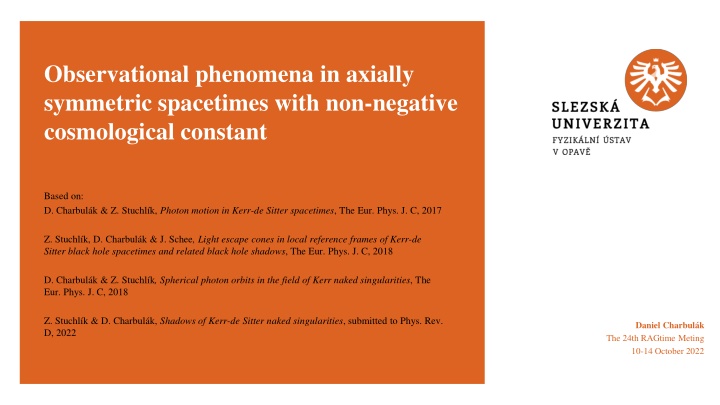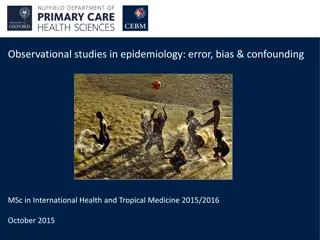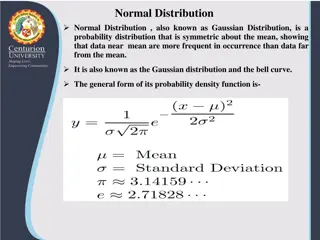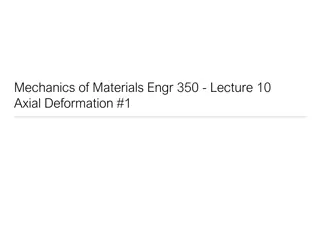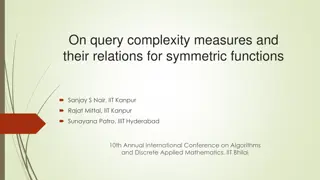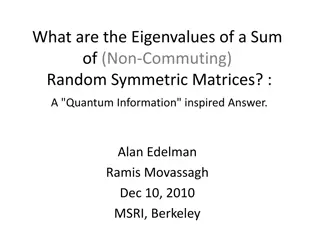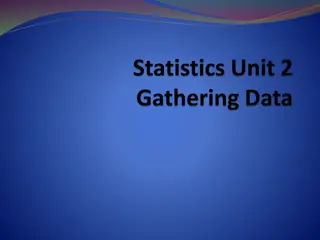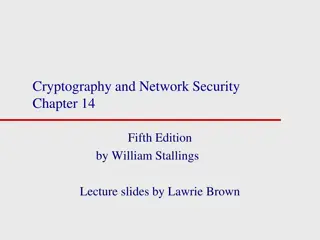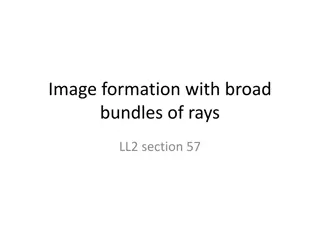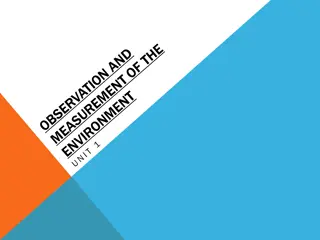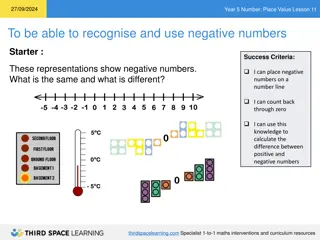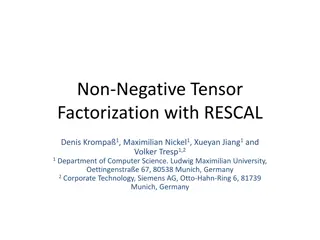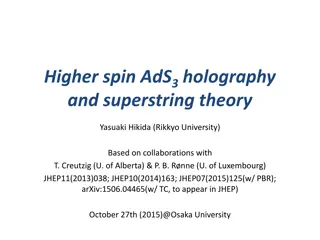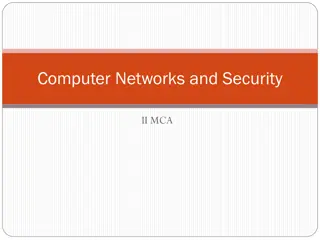Observational Phenomena in Axially Symmetric Spacetimes with Non-Negative Cosmological Constant
This study delves into observational phenomena in spacetimes with non-negative cosmological constants, focusing on photon motion, Kerr-de Sitter geometries, and shadows of Kerr-de Sitter naked singularities. Explore related concepts such as spherical photon orbits, measuring NS spin, and equations of motion for test particles and photons. Discover insights into the astrophysics community's interest in imaging black hole shadows and the progress in observational device development.
Download Presentation

Please find below an Image/Link to download the presentation.
The content on the website is provided AS IS for your information and personal use only. It may not be sold, licensed, or shared on other websites without obtaining consent from the author.If you encounter any issues during the download, it is possible that the publisher has removed the file from their server.
You are allowed to download the files provided on this website for personal or commercial use, subject to the condition that they are used lawfully. All files are the property of their respective owners.
The content on the website is provided AS IS for your information and personal use only. It may not be sold, licensed, or shared on other websites without obtaining consent from the author.
E N D
Presentation Transcript
Observational phenomena in axially symmetric spacetimes with non-negative cosmological constant Based on: D. Charbul k & Z. Stuchl k, Photon motion in Kerr-de Sitter spacetimes, The Eur. Phys. J. C, 2017 Z. Stuchl k, D. Charbul k & J. Schee, Light escape cones in local reference frames of Kerr-de Sitter black hole spacetimes and related black hole shadows, The Eur. Phys. J. C, 2018 D. Charbul k & Z. Stuchl k, Spherical photon orbits in the field of Kerr naked singularities, The Eur. Phys. J. C, 2018 Z. Stuchl k & D. Charbul k, Shadows of Kerr-de Sitter naked singularities, submitted to Phys. Rev. D, 2022 Daniel Charbul k The 24th RAGtime Meting 10-14 October 2022
Outline Motivation o the astrophysics community's interest in imaging the shadows of BHs after the first image was taken in the galaxy M87 o progress in development of observational devices (EHT, JWT, ...) Kerr de-Sitter (KdS) geometry and equations of motion Division of the KdS spacetimes according to character of the photon motion Some optical phenomena and their observational relevance o Measuring the KdS NS spin by observation shadows of compact objects o Spherical photon orbits (SPOs) in Kerr case and observational consequences Summary 2
Kerr-de Sitter geometry M mass parameter, J angular momentum of the central object , ? = ?- spin parameter Boyer-Lindquist coordinates {t, r, ?,?}/ geometric system of units c=G=1 cosmological constant ? =1 ? 3 ?2- dimensionless cosmological parameter ? ? ? = 1 (?,?,?,? ?????????????) ? ? ? ? ? ? ? ? ? ? Line element: ?2?2?? ?sin2???2+ ?sin2? ?= 1 + ?2?cos2? ?= (1 ??2)(?2+ ?2) I = 1 + ?2? ?2= ?2+ ?2cos2? ? ?? ?2 ?2??2+?2 ?2 ???2 ? (1) ??2= ???2+ ?2?2 Event horizons: ?=0 (3) (2) Ergosphere: ???= 0 (4) 3
Motion constants and equations of motion Test particle four-momentum: ? =??? Constants of motion: ????= 2for photons: = 0 ???,?= 0 ??= ? energy ???,?= 0 ??= axial angular momentum 2 ???2?+ ?2(?2 ?2)] = ? fourth Carter motion constant ??, ??= t,r, , | ? = ? 2+ cos2?[ ?? Carter s equations of geodesic motion of test particle: ?2??= ? ?2??= ? ?2? =???? ?? sin ?)2 ? = [? + ??2 ?2?2cos2?] ? ( ? = ??2 ?[?2?2+ ??2+ ?] ??= ?? ?2+ ?2 ?? ??= ??????2? ? ?? (5) (6) ? ? ?2+?2?? ? ????2? ??? ?2??= ? 5
Motion of photons Photon four-momentum: ? =??? ????= 0 ?? ? ?2?2 ?,? 0 - impact parameter Constants of motion: = ? = ? ? = 2 ? cos2?+? ???2? (7) ?(?) = ?2?2 ?2+ ? ? For computational purposes: ? ? = cos2?,?? ?2??= 2 ? ?(?) = ?2?2?[ 1 ? ?2+ ? ? (?? + ?)2] (8) ?(?) = ?2?2[ ?2 ??2 ?(?2+ ?)] (9) Reality conditions: (10) ?? ?? ? 1 ? ??2?+? ? ?2? ?( ? ?2?)] ? ?;? 0 ? ? ?(?;?) 0 ? ? (?) ??2 ??4+? ?2 ? effective potentials (11) ?2 ? 6
Spherical photon orbits (SPOs) and classification of the KdS spacetimes Stability condition: ?2? Conditions for existence of the SPOs: ? = 0,?? (12) (13) ??20 < 0 ??= 0 7
Light escape (capture) cones and related shadows of compact objects Construction of the LECs in local reference frame Locally Non-rotating Reference Frames (LNRFs) are accelerated frames to orbit at fixed coordinates ?,?, being carried by the rotation of the spacetime and having thus zero angular momentum; observers related to the LNRFs are also called Zero Angular Momentum Observers (ZAMOs) (14) (?)?? ?(?)= ?? Relation between coordinate components ??and locally measured components ?(?)of photon s wave vector ?: Locally measured directional angles ?,?: ?(?)= 1 ?(?)= cos? ?(?)= sin? cos? ?(?)= sin? sin? (15) Differential one-forms of the LNRFs: ? ??2 ?2? ?(?)= ?? ?2 ??? ?(?)= (16) ?2 ??? ?(?)= ????2? ?2?2(?? ??????) ?(?)= ?[ ??2+?2 ?] ? ??? ???= (17) ????= 8
LECs/ shadows of KdS naked singulariries/superspinars Class IVa: ?2= 1.2,? = 0.02 NS with polar SPOs: Class IVb: ?2= 2,? = 0.02 NS with no polar SPOs: + ??= 1.25 < ???? ??= 3.7 ?? ??= 3.7 ?? ??= ?max(????)= 8.3 ??= ?max(????)= 5.7 ??= 0 ??= ?m??(???)= 21.8 Class IVa ??= 73 ??= 66 > ????= 22 ??= 64 ? = 0.1 ??= 45 > ?m??(???) R = 0 r < 0 Class IVb ??= 90 ??= 90 Shadows Shadows LECs 9
Measuring NS spin/ observers latitude 2 Maximum spin parameter allowing existence of polar SPOs: Radii of polar SPOs for ?2< ?max ??? ? : 3?cosh? 2 2 2 = ? 11 + 2 1 ?2?2 ?max ??? cosh? =27 ? = 3 1 + 1 ? ? 3 ???? cos (18) (19) 3 2??max ??? ? = 6 3 9 = 1.39 cos? = (?2?2 1)(1 ?2?2 32 3) 2 ?max ??? ? 10
SPOs in the Kerr NS spacetimes Examples of various types of SPOs: Special cases: ? < 0 NAK E D S I N G U LAR I T I ES polar; ???= 0, ?2= 1.1,???? = 2.2 prograde - ??> 0; ?2= 1.1,? = 2 with zero nodal shift - ? = 0 ?2= 3,? = 1.7 BH ??> 0 event horizons equatorial circular orbits mixed, with ??= 0; ?2= 1.1,? = 2.6 retrograde - ??> 0; ?2= 1.1,? = 3.4 with negative energy - ? < 0 ?2= 1.1,? = 0.9 ?? 0 marginally stable SPOs polar SPOs ??< 0 zero nodal shift SPOs 11
SPOs related to Keplerian accretion disks and possible observational consequences The half-period of a photon on an orbit with zero nodal shift (return time to node): ????= 2?2?2+ ?2 2?? ??? ? ? ?+ ? ? ?+ ? ? ?+ ? ?+ (20) ? ?+ ? ?+ ?+ +4? + ?+ ? ? ?+ ? ? - positive/negative roots of ? ? , ? ? /?(?) complete elliptic integrals of first/second kind ???? - marginally stable circular equatorial orbits of the so-called I. family for particles ? 0 ???1,2 - orbits of zero-energy particles ?=0 (Z. Stuchl k, Equatorial circular orbits and the motion of the shell of dust in the field of a rotating naked singularity. Bull. Astronom. Inst. Czechoslov. 31, 129 144 (1980)) (21) In standard dimensional units: ????(???)=?? ?3 ???? For KNS a = 1.1: in the area of orbits of massive particles with negative energy, the possibility of capturing the extracted rotational energy of a naked singularity (superspinar) emitted in the form of el-mag. radiation or gravitational waves disruption of the stability and structure of the thin Keplerian disk ?~? ????(???)~0.01? Sgr ? : ?~106? ????(???)~103?~1/4 hour in the area of overlap of stable SPOs with the Keplerian accretion disc, the possibility of capturing thermal energy; self-illumination Center of galaxy M 87: ?~6.6 109? ????(???)~106?~12days periodic light echo, long-lasting afterglow sign of existence of NSs 12
Summary & plans for further work Kerr spacetimes: o Stable SPOs with zero nodal shift ? that could lead to periodic light echo or long-lasting afterglow Kerr de-Sitter (KdS) spacetimes: o Existence of maximum latitude ?max(????)allowing for occurrence of light circle in spacetimes with polar SPOs o Existence of minimum latitude ?m??(???)needed for occurrence of light arc in spacetimes with no polar SPOs o ? ??? < ?2< ?max ??? ? > ?(?max ??? o Observers in different state of motion? o Another spacetimes? 2 2 2 ? < ?2) 13
?(m; q, y, ??) Latitudinal motion behaviour of ? Case ?2? < 1 Lowest allowed value of ?: ????= ?2 ? = ? ( = 0) motion along the spin axis (stable) ?2< ? < 0 motion stably confined between two cones of constant latitude (vortical motion) o maxima ?+ ????= ?2cos4? o minima ? 2? ? = ?????2? 2? ? 0 motion confined to or crossing the equatorial plane (orbital motion) ? ????= ?cos2?, (Principal Null Congruences of the geometry) ? ? = ?cos2? 1 ?2 2 , 2 15
?(m; q, y, ??) Latitudinal motion behaviour of ? Case ?2? < 1 Case ?2? = 1 ? ?+ Case ?2? > 1 ? ?+ forbidden region, ? < 0 allowed region, ? 0 ? ? 16
Radial motion behaviour of ?(r; q, y, ??) KdS BLACK HOLE (BH) SPACETIMES WITH DIVERGENT REPULSIVE BARRIER (DRB): ? = 0.02,?2= 0.9 ? > 0 ? 0 ? 0 KdS BLACK HOLE (BH) SPACETIMES WITH RESTRICTED REPULSIVE BARRIER (RRB): ? = 0.04,?2= 0.9 ? 0 ? = 0 ? > 0 17
Radial motion behaviour of ?(r; q, y, ??) KdS NAKED SINGULARITY (NS) SPACETIMES WITH DIVERGENT REPULSIVE BARRIER (DRB): ? = 0.02,?2= 1.5 ? = 0 ? 0 ? > 0 KdS NAKED SINGULARITY (NS) SPACETIMES WITH RESTRICTED REPULSIVE BARRIER (RRB): ? = 0.04,?2= 1.5 ? = 0 ? 0 ? > 0 18
